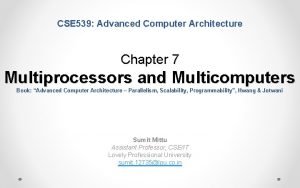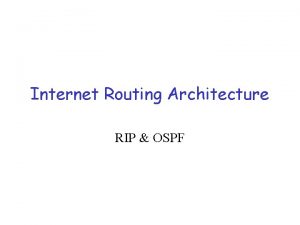Architecture Technology Corporation Specialists in Computer Architecture Routing














- Slides: 14

Architecture Technology Corporation Specialists in Computer Architecture Routing Optimization Techniques for Wireless Ad Hoc Networks Maher Kaddoura, Ranga Ramanujan, and Steven Schneider Architecture Technology Corporation Eden Prairie, MN, USA

Contribution • Routing optimization techniques that greatly enhance network performance. – Weighted Reservation (WR) • Reduce the number of nodes that reserve network resources. – Search Range Control • Reduce flooding. – Local Self-healing • Reduce route disconnection times. 2

Weighted Reservation • Route-Request Packet includes a counter that is incremented by each intermediate node. • Destination sets Route-Update Packet’s TTL to the distance between itself and Source plus a small value. • Intermediate node decrements the Route-Update Packet’s TTL as follows: – If the distance that separates the node from the Source is equal to or smaller than the distance that separate the Destination from Source , then decrement the packet’s TTL by 1. – If the distance that separates the node from Source is greater than the distance that separate Destination from Source, then decrement the packet’s TTL by the difference between the two distances. 3

Search Range Control • Source starts with small TTL value for Route. Request Packets and keep increasing it until it finds the desired route. 4

Local Self-healing • Phase I: Employed during route establishment. • Phase II: Used after the route has been established. • Phase III: Used if Phase I and II fail to repair the Route. 5

Phase I • Route-Update Packet includes a route log field, which contains an ordered sequence of route records, one for each node traversed by the Route-Update Packet. • A route record includes the address of the node and a log sequence number (log_seq). • A node’s log_seq is incremented each time the node is appended to a route log. 6

Phase I Route Repair • The node broadcasts a Local Self-healing Packet (LSP), which includes the route log that it received from Route. Update Packet. • An intermediate node processes LSP as follows: If the node can satisfy the route Qo. S parameters, it rebroadcasts the packet; Otherwise the node drops the packet. • A node along the route processes LSP as follows: – If the node is downstream from the node that issued the LSP, it replies with Local Self-healing Reply Packet (LSRP). – If the node is upstream from the node that issued the packet, it drops the packet. 7

Phase II • Periodically, each node sends an advertisement packet that includes its address and an advertisement sequence number along the path towards D. • A node advertisement sequence number is incremented each time a message is sent. 8

Phase II Route Repair • The node broadcasts a LSP, which includes the last advertisement sequence number it used. • Processing of the local self-healing messages is similar to Phase I. • A node determines if it is downstream for the node that initiated the repair: – If a node has received an advertisement packet from the node that initiated the route repair with an advertisement sequence number that matches the one in the LSP, it knows that it is downstream from the node that initiated route repair. 9

Phase III Route Repair • The node sends the route’s packets to Destination using best-effort route. • The node sends an error message to Source. • When Source receives an error message it reestablish a new route to Destination. 10

Simulation Environment • 64 identical nodes arranged in eight rows of eight nodes each. • 16 of the 64 nodes were designated as traffic sources. • 3 nodes were designated as destinations for the traffic sources. • Two sets of simulations – Several nodes in motion (Local Repair enabled/Disabled ). – Several nodes fail (Local Repair enabled/Disabled ). 11

Performance (1 of 2) Packets sent Packets Received Lost packets Local Selfhealing enabled 6097 6035 62 Local Selfhealing disabled 6097 5946 151 Nodes motion Packe ts sent Packets Receiv ed Lost packets Local Selfhealing enabled 6109 6067 42 Local Selfhealing disable d 6109 6020 89 Nodes failure The local self-healing optimization technique reduced the number of lost packets by up to 59%. 12

Performance (2 of 2) The time its takes to reconnect a disconnected route with and without local-self healing. 13

Conclusion By employing three new route optimization techniques, the new Qo. S-aware routing algorithm has the potential to significantly improve ad hoc network performance and Qo. S provisioning over that obtainable using presently existing techniques. 14
 Flood routing
Flood routing Static routing and dynamic routing
Static routing and dynamic routing Hydrologic continuity equation
Hydrologic continuity equation Clock routing
Clock routing Three generations of multicomputers
Three generations of multicomputers Calvin klein swot analysis
Calvin klein swot analysis Delglaze
Delglaze Global experience specialists stock
Global experience specialists stock Concrete hydrodemolition specialists
Concrete hydrodemolition specialists Types of retailers
Types of retailers Lawn care specialist work environment
Lawn care specialist work environment Surgerync com
Surgerync com Sisco
Sisco Psyc 1504 learning journal unit 1
Psyc 1504 learning journal unit 1 Memory technology in computer architecture
Memory technology in computer architecture


























